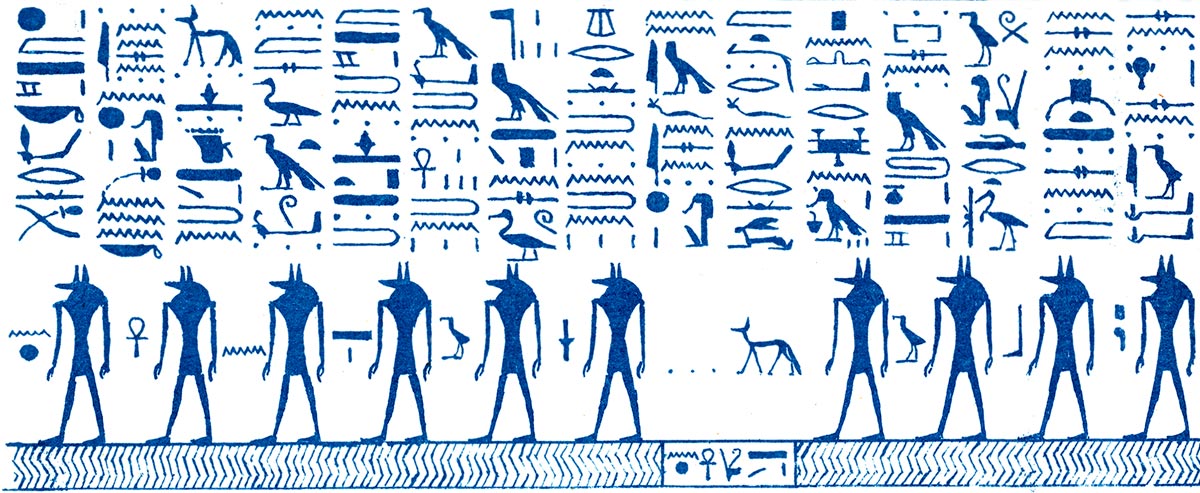-----
Language Analog: Nubian (roughly, as related to Ancient Egyptian)
Inspiration: Egyptian mythology (and, roughly, the Khenra of Magic: the Gathering)
-----
Tainted Counterpart: Gnolls *
Temperamental Association: Nihilist
* While they use the same statistics, the gnolls of Raviq are a different species from those of Prace. Pracian gnolls have short snouts with brown or tan fur; while Raviqi gnolls have long snouts and black or red fur. The two races have an instinctual hatred for one another. Fortunately, it is rare for the two to meet.
Female Names: Abeba, Aherash, Berhane, Bontu, Fadumo, Gadise, Hibo, Hiwot, Hodan, Kidist, Konjit, Lelise, Lulit, Meklit, Meti, Saynab, Seble, Worknesh, Xaawo, Xaliima
Unisex Names: Alemayehu, Desta, Lishan
-----
Anepu (singular anep) make their home in Anepet, the desert in the far south of Raviq on the border with Desolation. In the early days of the Pharaonic Empire, they were the keepers of the funerary traditions--and to this day retain a death-centered religion. In the ancient past, a single anep served as Pharaoh--though he took this position by force, murdering the previous neshu Pharaoh (and in turn being ousted by that Pharaoh's son).
Within southern and eastern Raviqi culture, the Neshu, Minotaurs, and Tengu have often been charged with the care (ie. rulership) of mortals; while it was the Anepu who have always cared for the Empire's dead. The dogfolk include architects and builders of tombs; physicians and embalmers; funerary priests and professional mourners. Their culture is steeped in prepping themselves and others for the afterlife. Much of the foundation of Ren-Heka comes from anepu tradition--preserving names and legacies for the world to come.
This is not to say that anepu are solely focused on death, however. They merely accept it openly as a natural stage of life. Death is neither the end nor the beginning. Anepu love life, and their physicians (often alchemist artificers) are dedicated to preserving it. They have strong warrior and scholarly traditions; and the lupin "pack" are known as far north as tengu territory for their thick, meal-like beer.
Most anepu venerate the pantheon of Netjeru common among the other Raviqi race, as well as serve the living Pharaoh as temporal governor. The shafolk, however, do not. In fact, this independent "pack" is often considered vitalist (instead of nihilist as the bulk of the race). These anepu consider themselves the oldest of their race--and the other "packs" do not argue with this assertion. The anep who served as Pharaoh had been a shafolk; and the neshu trace this pack's dissent from the Empire to the removal of the anepu usurper.
Dogfolk Stats & Subraces
As a baseline, dogfolk use the stats of the khenra from Plane Shift, applying appropriate sub-race traits as necessary. Anepu speak the anepti (racial) and raviqi (local common) languages.The subraces available to the anepu are outlined below.
- Lupin, resembling wild-dogs, typically follow the "mundane" roles of the warrior and expert classes.
- Hutaaken, resmbling jackals, typically follow the more "mystic" roles of the priestly and magical classes.
- Shafolk, resembling the sha-beasts of the wastes, exist in a fringe community along the Desolation border.
Sha, Dire Jackals
Sha are beasts common to the wastelands of Raviq--most commonly seen in Nefret, Anepet, and Desolation. They are a canine similar to dire wolves, with a closer resemblance to jackals--but with squared ears, forked tails, and red fur. Use the stats of the dire wolf for the sha-beasts.

No comments:
Post a Comment